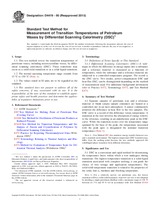Potřebujeme váš souhlas k využití jednotlivých dat, aby se vám mimo jiné mohly ukazovat informace týkající se vašich zájmů. Souhlas udělíte kliknutím na tlačítko „OK“.
ASTM D4419-90(2015)
Standard Test Method for Measurement of Transition Temperatures of Petroleum Waxes by Differential Scanning Calorimetry (DSC)
Automaticky přeložený název:
Standardní zkušební metoda pro měření teploty přechodu z ropných vosků diferenční skenovací kalorimetrií ( DSC )
NORMA vydána dne 1.4.2015
Informace o normě:
Označení normy: ASTM D4419-90(2015)
Poznámka: NEPLATNÁ
Datum vydání normy: 1.4.2015
Kód zboží: NS-588676
Počet stran: 4
Přibližná hmotnost: 12 g (0.03 liber)
Země: Americká technická norma
Kategorie: Technické normy ASTM
Kategorie - podobné normy:
Anotace textu normy ASTM D4419-90(2015) :
Keywords:
differential scanning calorimetry, petroleum wax, thermal properties, transition temperature ,, ICS Number Code 75.140 (Waxes, bituminous materials and other petroleum products)
Doplňující informace
| Significance and Use | ||||||||||||
|
5.1 DSC in a convenient and rapid method for determining the temperature limits within which a wax undergoes during transitions. The highest temperature transition is a solid-liquid transition associated with complete melting; it can guide the choice of wax storage and application temperatures. The solid-solid temperature transition is related to the properties of the solid, that is, hardness and blocking temperature. Note 2: For a relatively narrow cut petroleum wax, the lowest
transition will be a solid-solid transition. A narrow cut wax is
one obtained by deoiling a single petroleum distillate with a
maximum range of 120 °F between its 5 % and 95 % vol in accordance
with Test Method D1160
boiling points (converted to 760 torr). The DSC method cannot
differentiate between solid-liquid and solid-solid transitions.
Such information must be predetermined by other techniques. In the
case of blends, the lower temperature transition may be envelopes
of both solid-liquid and solid-solid transitions.
5.2 Since petroleum wax is a mixture of hydrocarbons with different molecular weights, its transitions occur over a temperature range. This range is one factor that influences the width, expressed in °C, of the DSC peaks. The highest temperature transition is a first-order transition. If, for a series of waxes, there is supporting evidence that the highest temperature transition of each wax is the major first-order transition, its relative width should correlate with the relative width of the wax's molecular weight distribution. |
||||||||||||
| 1. Scope | ||||||||||||
|
1.1 This test method covers the transition temperatures of petroleum waxes, including microcrystalline waxes, by differential scanning calorimetry (DSC). These transitions may occur as a solid-solid transition or as a solid-liquid transition. 1.2 The normal operating temperature range extends from 15 °C to 150 °C (Note 1). 1.3 The values stated in SI units are to be regarded as the standard. 1.4 This standard does not purport to address all of the safety concerns, if any, associated with its use. It is the responsibility of the user of this standard to establish appropriate safety and health practices and determine the applicability of regulatory limitations prior to use. |
||||||||||||
| 2. Referenced Documents | ||||||||||||
|
Doporučujeme:
Aktualizace technických norem
Chcete mít jistotu, že používáte pouze platné technické normy?
Nabízíme Vám řešení, které Vám zajistí měsíční přehled o aktuálnosti norem, které používáte.
Chcete vědět více informací? Podívejte se na tuto stránku.




 Cookies
Cookies
